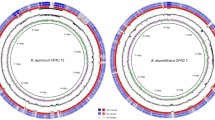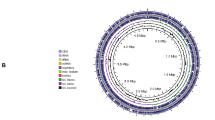Abstract
Soybean is the most inoculant-consuming crop in the world, carrying strains belonging to the extremely related species Bradyrhizobium japonicum and Bradyrhizobium diazoefficiens. Currently, it is well known that B. japonicum has higher efficiency of soybean colonization than B. diazoefficiens, but the molecular mechanism underlying this differential symbiotic performance remains unclear. In the present study, genome resequencing of four spontaneous oxidative stress–resistant mutants derived from the commercial strain B. japonicum E109 combined with molecular and physiological studies allowed identifying an antioxidant cluster (BjAC) containing a transcriptional regulator (glxA) that controls the expression of a catalase (catA) and a phosphohydrolase (yfbR) related to the hydrolysis of hydrogen peroxide and oxidized nucleotides, respectively. Integrated synteny and phylogenetic analyses supported the fact that BjAC emergence in the B. japonicum lineage occurred after its divergence from the B. diazoefficiens lineage. The transformation of the model bacterium B. diazoefficiens USDA110 with BjAC from E109 significantly increased its ability to colonize soybean roots, experimentally recapitulating the beneficial effects of the occurrence of BjAC in B. japonicum. In addition, the glxA mutation significantly increased the nodulation competitiveness and plant growth–promoting efficiency of E109. Finally, the potential applications of these types of non-genetically modified mutant microbes in soybean production worldwide are discussed.






Similar content being viewed by others
References
Santos MS, Nogueira MA, Hungria M (2019) Microbial inoculants: reviewing the past, discussing the present and previewing an outstanding future for the use of beneficial bacteria in agriculture. AMB Express 9:205. https://doi.org/10.1186/s13568-019-0932-0
Jozefkowicz C, Brambilla S, Frare R, Stritzler M, Puente M, Piccinetti C, Soto G, Ayub N (2017) Microevolution rather than large genome divergence determines the effectiveness of legume-rhizobia symbiotic interaction under field conditions. J Mol Evol 85:79–83. https://doi.org/10.1007/s00239-017-9808-6
Siqueira AF, Ormeno-Orrillo E, Souza RC, Rodrigues EP, Almeida LG, Barcellos FG, Batista JS, Nakatani AS, Martinez-Romero E, Vasconcelos AT, Hungria M (2014) Comparative genomics of Bradyrhizobium japonicum CPAC 15 and Bradyrhizobium diazoefficiens CPAC 7: elite model strains for understanding symbiotic performance with soybean. BMC Genomics 15:420. https://doi.org/10.1186/1471-2164-15-420
Torres D, Revale S, Obando M, Maroniche G, Paris G, Perticari A, Vazquez M, Wisniewski-Dye F, Martinez-Abarca F, Cassan F (2015) Genome sequence of Bradyrhizobium japonicum E109, one of the most agronomically used nitrogen-fixing rhizobacteria in Argentina. Genome Announc 3. https://doi.org/10.1128/genomeA.01566-14
Jozefkowicz C, Brambilla S, Frare R, Stritzler M, Piccinetti C, Puente M, Berini CA, Pérez PR, Soto G, Ayub N (2017) Stable symbiotic nitrogen fixation under water-deficit field conditions by a stress-tolerant alfalfa microsymbiont and its complete genome sequence. J Biotechnol 263:52–54. https://doi.org/10.1016/j.jbiotec.2017.10.007
Mendes IC, Hungria M, Vargas MAT (2004) Establishment of Bradyrhizobium japonicum and B. elkanii strains in a Brazilian Cerrado oxisol. Biol Fert Soils 40:28–35. https://doi.org/10.1007/s00374-004-0739-1
Silva Batista JS, Hungria M, Barcellos FG, Ferreira MC, Mendes IC (2007) Variability in Bradyrhizobium japonicum and B. elkanii seven years after introduction of both the exotic microsymbiont and the soybean host in a cerrados soil. Microb Ecol 53:270–284. https://doi.org/10.1007/s00248-006-9149-2
Barros-Carvalho GA, Hungria M, Lopes FM, Van Sluys MA (2019) Brazilian-adapted soybean Bradyrhizobium strains uncover IS elements with potential impact on biological nitrogen fixation. FEMS Microbiol Lett 366. https://doi.org/10.1093/femsle/fnz046
Soto MJ, Sanjuán J, Olivares J (2006) Rhizobia and plant-pathogenic bacteria: common infection weapons. Microbiology (Reading, England) 152:3167–3174. https://doi.org/10.1099/mic.0.29112-0
Tang G, Li N, Liu Y, Yu L, Yan J, Luo L (2018) Sinorhizobium meliloti glutathione reductase is required for both redox homeostasis and symbiosis. Appl Environ Microbiol 84. https://doi.org/10.1128/aem.01937-17
Hu A, Chen X, Luo S, Zou Q, Xie J, He D, Li X, Cheng G (2021) Rhizobium leguminosarum glutathione peroxidase is essential for oxidative stress resistance and efficient nodulation. Front Microbiol 12:627562. https://doi.org/10.3389/fmicb.2021.627562
Jeon JM, Lee HI, Donati AJ, So JS, Emerich DW, Chang WS (2011) Whole-genome expression profiling of Bradyrhizobium japonicum in response to hydrogen peroxide. Mol Plant Microbe Interact 24:1472–1481. https://doi.org/10.1094/mpmi-03-11-0072
Donati AJ, Jeon JM, Sangurdekar D, So JS, Chang WS (2011) Genome-wide transcriptional and physiological responses of Bradyrhizobium japonicum to paraquat-mediated oxidative stress. Appl Environ Microbiol 77:3633–3643. https://doi.org/10.1128/aem.00047-11
Stępkowski T, Banasiewicz J, Granada CE, Andrews M, Passaglia LMP (2018) Phylogeny and phylogeography of rhizobial symbionts nodulating legumes of the Tribe Genisteae. Genes 9. https://doi.org/10.3390/genes9030163
Stritzler M, Diez Tissera A, Soto G, Ayub N (2018) Plant growth-promoting bacterium Pseudomonas fluorescens FR1 secrets a novel type of extracellular polyhydroxybutyrate polymerase involved in abiotic stress response in plants. Biotechnol Lett 40:1419–1423. https://doi.org/10.1007/s10529-018-2576-6
Ayub ND, Pettinari MJ, Ruiz JA, López NI (2004) A polyhydroxybutyrate-producing Pseudomonas sp. isolated from Antarctic environments with high stress resistance. Curr Microbiol 49:170–174. https://doi.org/10.1007/s00284-004-4254-2
Kovach ME, Elzer PH, Hill DS, Robertson GT, Farris MA, Roop RM 2nd, Peterson KM (1995) Four new derivatives of the broad-host-range cloning vector pBBR1MCS, carrying different antibiotic-resistance cassettes. Gene 166:175–176. https://doi.org/10.1016/0378-1119(95)00584-1
Hattermann DR, Stacey G (1990) Efficient DNA transformation of Bradyrhizobium japonicum by electroporation. Appl Environ Microbiol 56:833–836. https://doi.org/10.1128/aem.56.4.833-836.1990
Ledermann R, Bartsch I, Müller B, Wülser J, Fischer HM (2018) A functional general stress response of Bradyrhizobium diazoefficiens is required for early stages of host plant infection. Mol Plant Microbe Interact 31:537–547. https://doi.org/10.1094/mpmi-11-17-0284-r
Lee H-I, Lee J-H, Park K-H, Sangurdekar D, Chang W-S (2012) Effect of soybean coumestrol on Bradyrhizobium japonicum nodulation ability, biofilm formation, and transcriptional profile. Appl Environ Microbiol 78:2896–2903. https://doi.org/10.1128/AEM.07336-11
Ledermann R, Bartsch I, Remus-Emsermann MN, Vorholt JA, Fischer HM (2015) Stable fluorescent and enzymatic tagging of Bradyrhizobium diazoefficiens to analyze host-plant infection and colonization. Mol Plant Microbe Interact 28:959–967. https://doi.org/10.1094/mpmi-03-15-0054-ta
Setten L, Soto G, Mozzicafreddo M, Fox AR, Lisi C, Cuccioloni M, Angeletti M, Pagano E, Diaz-Paleo A, Ayub ND (2013) Engineering Pseudomonas protegens Pf-5 for nitrogen fixation and its application to improve plant growth under nitrogen-deficient conditions. PLoS ONE 8:e63666. https://doi.org/10.1371/journal.pone.0063666
Carrera CS, Dardanelli JL, Soldini DO (2014) Genotypic and environmental variation in seed nutraceutical and industrial composition of non-transgenic soybean Glycine max genotypes. Crop Pasture Sci 65:1311–1322. https://doi.org/10.1071/CP14114
Marioli Nobile CG, Balzarini M, Aguate FM, Grosso NR, Soldini DO, Zeng H, Cheng W-H, Martínez MJ (2016) Climatic thresholds for concentrations of minerals and heavy metals in argentinean soybean. Agron J 108:532–539. https://doi.org/10.2134/agronj2015.0445
Setten L, Soto G, Mozzicafreddo M, Fox AR, Lisi C, Cuccioloni M, Angeletti M, Pagano E, Díaz-Paleo A, Ayub ND (2013) Engineering Pseudomonas protegens Pf-5 for nitrogen fixation and its application to improve plant growth under nitrogen-deficient conditions. PLoS ONE 8:e63666. https://doi.org/10.1371/journal.pone.0063666
Jiménez-Leiva A, Cabrera JJ, Bueno E, Torres MJ, Salazar S, Bedmar EJ, Delgado MJ, Mesa S (2019) Expanding the regulon of the Bradyrhizobium diazoefficiens NnrR transcription factor: new insights into the denitrification pathway. Frontiers in Microbiology 10. https://doi.org/10.3389/fmicb.2019.01926
Kearse M, Moir R, Wilson A, Stones-Havas S, Cheung M, Sturrock S, Buxton S, Cooper A, Markowitz S, Duran C, Thierer T, Ashton B, Meintjes P, Drummond A (2012) Geneious basic: an integrated and extendable desktop software platform for the organization and analysis of sequence data. Bioinformatics 28:1647–1649. https://doi.org/10.1093/bioinformatics/bts199
Kumar S, Stecher G, Tamura K (2016) MEGA7: molecular evolutionary genetics analysis version 7.0 for bigger datasets. Mol Biol Evol 33:1870–1874. https://doi.org/10.1093/molbev/msw054
Zamocky M, Gasselhuber B, Furtmuller PG, Obinger C (2012) Molecular evolution of hydrogen peroxide degrading enzymes. Arch Biochem Biophys 525:131–144. https://doi.org/10.1016/j.abb.2012.01.017
Zimmerman MD, Proudfoot M, Yakunin A, Minor W (2008) Structural insight into the mechanism of substrate specificity and catalytic activity of an HD-domain phosphohydrolase: the 5’-deoxyribonucleotidase YfbR from Escherichia coli. J Mol Biol 378:215–226. https://doi.org/10.1016/j.jmb.2008.02.036
Fixen KR, Starkenburg SR, Hovde BT, Johnson SL, Deodato CR, Daligault HE, Davenport KW, Harwood CS, Cattolico RA (2016) Genome sequences of eight bacterial species found in coculture with the haptophyte Chrysochromulina tobin. Genome Announc 4. https://doi.org/10.1128/genomeA.01162-16
Petassi MT, Hsieh SC, Peters JE (2020) Guide RNA categorization enables target site choice in Tn7-CRISPR-Cas transposons. Cell 183:1757.e1718-1771.e1718. https://doi.org/10.1016/j.cell.2020.11.005
Crespo-Rivas JC, Navarro-Gomez P, Alias-Villegas C, Shi J, Zhen T, Niu Y, Cuellar V, Moreno J, Cubo T, Vinardell JM, Ruiz-Sainz JE, Acosta-Jurado S, Soto MJ (2019) Sinorhizobium fredii HH103 RirA is required for oxidative stress resistance and efficient symbiosis with soybean. Int J Mol Sci 20. https://doi.org/10.3390/ijms20030787
de Souza RSC, Armanhi JSL, Arruda P (2020) From microbiome to traits: designing synthetic microbial communities for improved crop resiliency. Front Plant Sci 11. https://doi.org/10.3389/fpls.2020.01179
Brambilla S, Frare R, Stritzler M, Soto G, Berini C, Jozefkowicz C, Ayub N (2020) Synthetic multi-antibiotic resistant plasmids in plant-associated bacteria from agricultural soils. JGAR 22:113–116. https://doi.org/10.1016/j.jgar.2020.01.015
Acknowledgements
We thank Andrea Puebla and Pablo Vera (IABIMO) for their technical support in genomic sequencing.
Funding
This work was supported by Grants PICT-2017–0674 and FVT-39–2017, PICT-2018–02644 provided to Dr. Nicolas Ayub and by PE I115 and PE I116 (Biotechnology Program of INTA).
Author information
Authors and Affiliations
Contributions
All authors contributed to the study conception and design. Conceived and designed the experiments: K. L., G. S., and N. A. Performed the experiments: K. L., C. G., S. B., R. F., M. S., and V. M. Analyzed the data: O. R., D. S., C. P., G. S., and N. A.. Wrote the paper: N. A. All authors read and approved the final manuscript.
Corresponding author
Ethics declarations
Conflict of Interest
The authors declare no competing interests.
Supplementary Information
Below is the link to the electronic supplementary material.
Rights and permissions
About this article
Cite this article
Liebrenz, K., Gómez, C., Brambilla, S. et al. Whole-Genome Resequencing of Spontaneous Oxidative Stress-Resistant Mutants Reveals an Antioxidant System of Bradyrhizobium japonicum Involved in Soybean Colonization. Microb Ecol 84, 1133–1140 (2022). https://doi.org/10.1007/s00248-021-01925-2
Received:
Accepted:
Published:
Issue Date:
DOI: https://doi.org/10.1007/s00248-021-01925-2




